Gigabyte's GA-MA785GPMT-UD2H - AMD's 785G is Here, Sort of...
by Gary Key on July 14, 2009 11:00 PM EST- Posted in
- Motherboards
Like a good spy, we searched all over two continents for a motherboard containing AMD's 785G chipset. Once we identified our target, we scoped it out, formulated a snatch and grab plan, and then waited until the time was right. We thought the time was right last week to swoop in and grab the object of our desire. Sure enough, the plan went off without a hitch as we brought the Gigabyte GA-MA785GPMT-UD2H back to the labs for integration. Before we could even try our hands at waterboarding Gigabyte's latest multimedia wonder, testing came to a grinding halt.
It seems that in our rush to secure this motherboard that we overlooked one very important aspect during our investigation. It turns out the driver set we were privy to for testing is an early beta set missing several important driver features while AMD is still optimizing performance. We encountered no stability problems running a multitude of benchmarks, but the lack of features and optimizations preclude us from publishing a meaningful first look, especially for those looking to use this new platform in an HTPC or SFF gaming system. Of course, there were discussions with AMD explaining some of the early problems we ran into during testing. As such, AMD requested that we wait until the drivers are mature and based on early test results we will heed their requests.
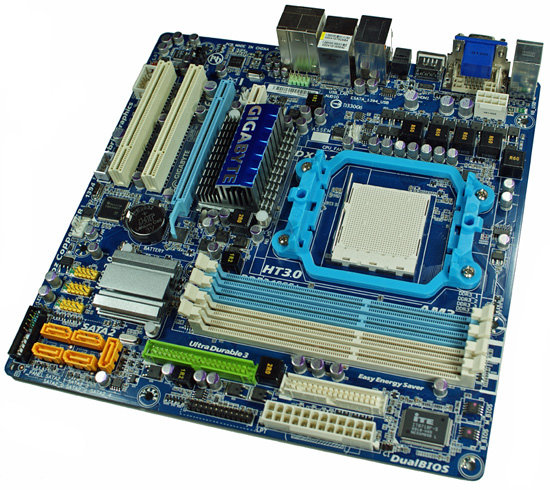
What we can do today is discuss some early observations and provide a couple of results that are indicative of the board's capability with an early BIOS and a quick look at Blu-ray playback results. First off, even with less than stellar drivers, the board's performance was equal to or better than the current 780G/790GX motherboards and it will only improve. How much is up for discussion as AMD designated the new chipset just a half point higher for a reason.
The graphics core in the 785G is upgraded from the HD3200/3300 utilized in the 780G/790GX to the HD4200. The primary difference between the cores is that the HD4200 fully supports DX10.1, Unified Video Decoder 2.0 (UVD), hardware accelerated picture in picture capabilities, dynamic contrast, HQ video scaling, hardware accelerated video transcoding, and full Powerplay support. The graphics core still runs at 500MHz (in current form) and at least in our particular sample, we were able to reach 1057MHz without too much trouble.
What does all this mean? For one, thanks to the HD4200, AMD finally offers multi-channel LPCM audio output plus additional hardware video accelerated functions. As far as performance is concerned, expect a 5%~ 15% performance increase in games. That sounds impressive, but playing the Sims3 at 1024x768 with medium quality settings resulted in an average framerate increase from 23.9fps on the 780G to 26.1fps on the 785G with alpha level drivers. The biggest difference occurred in minimum frame rates with an increase from 12fps on the 780G to 15fps on the 785G. Otherwise, the GPU capabilities are fine for casual gaming (Plants vs Zombies) and flash based games.
Of course most users purchasing this type of product are not that interested in gaming and if you are, then we highly suggest buying a HD 4770 or HD 4850 for 1680x1050 or below resolutions. Anything higher, and we suggest a HD 4890 based on current price to performance ratios. The main purpose of this chipset is to capture the mainstream desktop market, you know, the market where 90% of units sold are with integrated graphic capabilities only.
When paired with the Athlon II X2 250 processor we utilized in early testing, this platform is an extremely compelling alternative to the Intel G41/E6300 combination. Considering the number of features and platform performance that AMD provides with the 785G/SB710 chipset compared to the G41/ICH7, we have to wonder why one go the Intel route, even this early in the game. Our original plans called for a direct comparison between the two platforms but that will have to wait until the official release next month with production ready drivers. AMD will have an official release candidate ready shortly and we expect the boards to ship with the 9.8 Catalyst driver set.
That said, early results with HD video playback are very promising. However, the majority of missing driver features center on the lack of Avivo options. Vector Adaptive de-interlacing was working in our driver set with Aero enabled under Windows 7 Ultimate x64 (build 7600), but we noticed some slight edge flickering in titles like Wanted and The Dark Knight. The entire Avivo section in the driver set is missing so we do not know if features like HD Color Vibrance, HD Flesh Tone, HD Pulldown detection, HD edge enhancement, and dynamic contrast will be fully supported or not. We have asked the question and will have an update once we get an answer. 1080p/24 support is working properly as is multi-channel LPCM audio output through several A/V receivers.
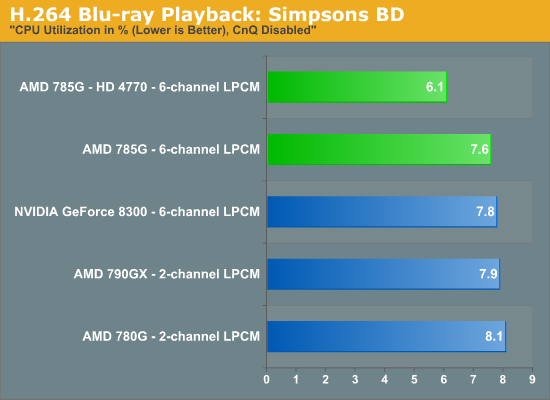
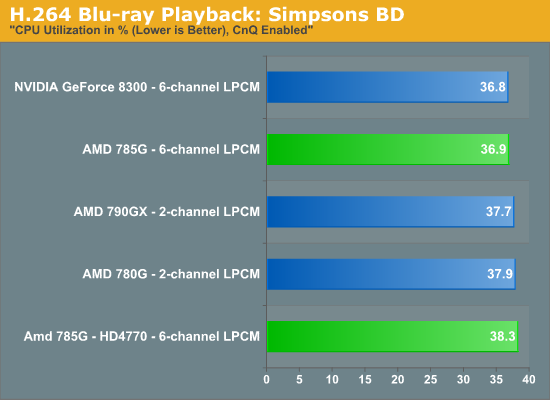
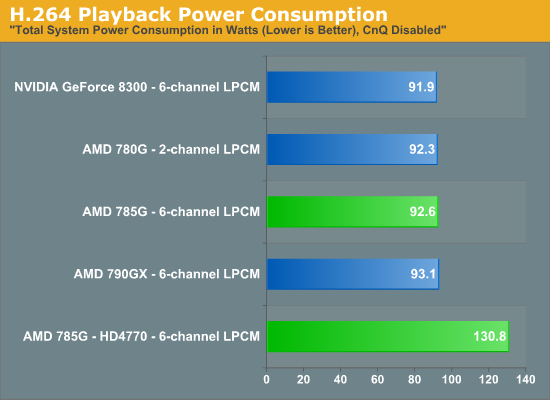
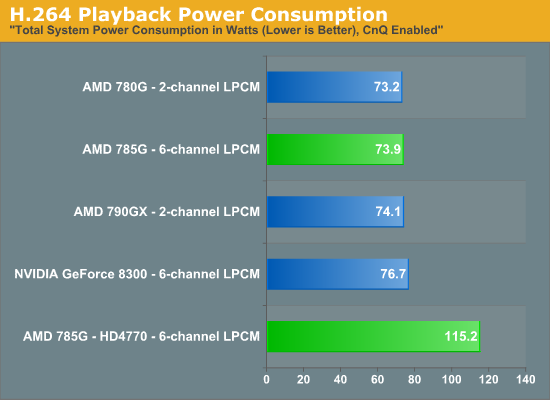
In our only test today we see very good results in the Blu-ray playback capabilities of the 785G. So much so, that unless something drastic happens in the next driver release, we will stop recommending the purchase of a discrete video card on the AMD chipset platforms. We did not have any HDMI incompatibilities, no repeater issues to report, the 785G just worked and we think it will only get better.
Gigabyte has produced yet another sterling uATX motherboard that is fully featured. The full specification sheet is in our Gallery. We will not get into the all of the specifics today but one question that needs to be answered concerns the ability of the chipset/board to unlock the Athlon II X2 550 or Phenom II X3 720BE processors as one example. This board had no problems unlocking our particular retail units although your mileage will vary based on processor quality and BIOS options.
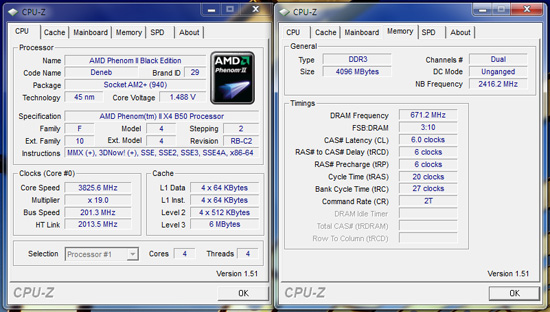
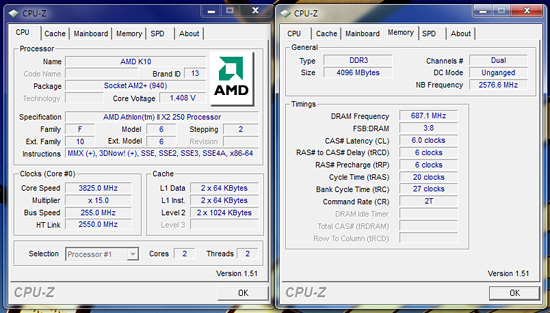
We utilized a retail Phenom II X4 955BE heatsink/fan for our overclock results. These coolers work great for overclocking either Athlon II X2 processor. The Athlon II X2 550 BE is unlocked with all four cores working properly and a nice stable overclock to 3.825GHz (19x201) on 1.50V. Our Athlon II X2 250 had no problems reaching a stable 3.825GHz (15x255) on 1.425V. We are using Windows 7 x64 so our final clock speeds are limited somewhat by the 4GHz ceiling we typically run into with the Phenom II/x64 combination.
That is it for our preview follow-up, suffice to say that AMD has produced another very good chipset that provides the most cost effective IG performance in the market. The Gigabyte GA-MA785GPMT-UD2H is quickly shaping up to be one of the boards to have when the 785G launches next month.






















30 Comments
View All Comments
sprockkets - Thursday, July 16, 2009 - link
Wait, OK, seems that both ATi and nVidia work with DXA right?Well, I'll probably still get the Zotac 9300 board w/Pentium DC anyhow.
Spoelie - Friday, July 17, 2009 - link
It works with both, with the following caveats:*ATi only supports *some* videos, in essence those with 4 or less ref frames @1080p, or 9 or less ref frames @720p - Nvidia supports ALL videos, as long as the card has PureVideo2 (I think, dunno about the 9300 chipset).
*ATi does provide VC1 decoding support while nvidia does not, but VC1 decoding is lighter on the processing requirements compared to H.264 anyway, so don't know if that's a big deal.
sprockkets - Thursday, July 16, 2009 - link
But does it work with ATi stuff? Same question goes for Linux. Otherwise, I'll have to stick with nVidia stuff.psychobriggsy - Wednesday, July 15, 2009 - link
Good to hear that the integrated graphics is good enough for all but non-casual gaming. Surely this will be very popular in media PCs once it is released. Indeed it is good enough to put off the purchase of something now if you are going to be building a media PC.What was the performance like when it was overclocked to over 1GHz, as you article says you did?
Next step, AMD's southbridge...
(weird, this comment post page was just redirecting to Anandtech's search page just now)
mindless1 - Thursday, July 16, 2009 - link
It's not good enough for all but non-casual gaming, you don't have to be a hardcore gamer to plop down $20 on last year's title and find you can't play at native resolution on a cheap 22" LCD.There is no reason to think it's particularly popular in HTPCs, several IGPs do HD decoding and any small gains are irrelevant compared to driver support for any of them, a point also mentioned in the article.
It's just senseless to pretend performance matters in an IGP compared to basic HD and driver support, when systems cost at least $300 and a proper video card costs no more than the cost of a couple discounted games or one new game.
I appreciate that IGPs are boring and an article has to try and find the differences, but it is also useful to remember that tiny evolutionary differences should be seen for what they are, IGPs almost always get a tiny bit faster so basically 785 is just another disappointment in being nothing more than a minor, industry typical, gain.
That's not to put down the IGP or IGP products in general, it is great they have the performance and capabilities they do now, but in the end we have reached the point where gaming performance from them is still irrelevant and HTPC was already as mature as it needs be and will be for the next few generations so ultimately their goal should be to lower price so it is more attractive in systems where a system integrator would otherwise pick something else (like an Intel chipset) to lower costs.
Spoelie - Thursday, July 16, 2009 - link
*For games like the sims that reach popular mass, IGPs do a good enough job, and the difference in performance matters for this. Also with the introduction of the 3D accelerated desktop, the baseline performance expected of an IGP took a sudden jump and Intel was caught with their pants down. Another such jump will occur as compute shaders/opencl becomes more and more prevalent (timeframe big unknown tho), performance will matter more, but by then we're probably talking about IGPs as part of the CPU.*The differences in HD support are big enough that one would be unsuitable while the other barely passes. 6ch vs 2ch LPCM, H.264 L4.1 vs L5.0 support, ... These differences still exist today so I don't agree that HTPC has reached a point of maturity, they still need to step up their game.
gipper - Wednesday, July 15, 2009 - link
Speaking of LPCM, has there been any progress with playing back Blu-ray discs or rips without the software downsampling the audio?brausekopf - Wednesday, July 15, 2009 - link
The chipset heatsink seems to take a lot of space.And if there is enough room will a card be roasted
by the heatsink?
Otherwise: I like to see the floppy port and hope
to see a PS/2 port.
mamisano - Wednesday, July 15, 2009 - link
Any word on this being used as the basis of a 795GX chipset? Would be a nice option to the 785G if it included higher clock speeds (binned chips?) and side-port memory.Can't wait to see the full review next month :)
AlB80 - Wednesday, July 15, 2009 - link
760G/780V/780G/790GX has the same crystal. If there will be new chip then all of them get it (maybe with 760G exception).